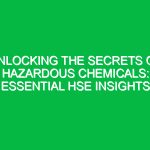Introduction
In the world of Health, Safety, and Environment (HSE), understanding the concepts of hazard and risk is paramount. These terms, often used interchangeably, carry distinct meanings that play a crucial role in workplace safety and environmental protection. A hazard refers to any source of potential damage, harm, or adverse effects, while risk is the likelihood that this harm will occur when exposed to the hazard. This differentiation is essential not just for compliance with regulations but also for developing effective safety strategies that protect workers and the environment.
To illustrate this point, consider a construction site. The heavy machinery present represents a hazard due to its potential to cause injury. However, the risk of injury will vary depending on several factors, such as the level of training workers have received, the safety measures in place, and the operational practices followed. Understanding the nuances of hazard vs risk equips organizations to make informed decisions about safety protocols and risk management strategies.
Key Aspects of Hazard vs Risk in HSE
Defining Hazard
A hazard can be classified into several categories, including:
- Physical Hazards: These include conditions that can cause physical harm, such as machinery, heights, or electrical equipment.
- Chemical Hazards: Substances that can cause harm if inhaled, ingested, or come into contact with skin, like solvents or acids.
- Biological Hazards: These involve risks arising from exposure to harmful biological agents, such as bacteria, viruses, or mold.
- Ergonomic Hazards: Issues related to how work is organized, which can lead to musculoskeletal disorders.
Identifying hazards is the first step in creating a safe work environment. This requires regular inspections, employee input, and a thorough understanding of the operational processes.
Understanding Risk
Risk, on the other hand, is a function of both the hazard and the exposure. It can be quantified and managed through various methods. In the context of HSE, risk assessment is a critical process that involves the following steps:
- Identification: Determine which hazards are present in the workplace.
- Analysis: Evaluate the risk associated with each hazard. This includes considering factors like frequency of exposure and severity of potential outcomes.
- Evaluation: Compare estimated risks against predetermined criteria to determine their significance.
- Control: Implement measures to eliminate or mitigate risks.
Understanding risk helps organizations prioritize their safety initiatives and allocate resources effectively.
The Importance of Hazard vs Risk in HSE
The distinction between hazard and risk is not merely academic; it has real-world implications for workplace safety and environmental protection. Several key factors illustrate why this understanding is vital:
Preventing Accidents
A thorough understanding of hazards and associated risks allows organizations to develop targeted strategies for accident prevention. For example, a manufacturing plant may recognize that the use of certain chemicals poses a significant hazard. By conducting a risk assessment, they can identify the likelihood of exposure and implement necessary controls, such as personal protective equipment (PPE) and proper ventilation, to minimize the risk of accidents.
Compliance with Regulations
Various organizations and governments have set forth regulations that require businesses to conduct risk assessments and implement safety measures. For instance, the Occupational Safety and Health Administration (OSHA) in the United States mandates that employers identify and mitigate hazards in the workplace. Understanding hazard vs risk is fundamental for compliance with these regulations, helping organizations avoid legal penalties and protect their reputation.
Enhancing Workplace Culture
When employees understand the difference between hazard and risk, they are more likely to engage in safe practices and participate in safety programs. This cultural shift can lead to a proactive approach to health and safety, where employees feel empowered to identify hazards and suggest improvements.
Best Practices for Managing Hazard vs Risk
Effective management of hazards and risks requires a structured approach. Here are some best practices to consider:
1. Conduct Regular Risk Assessments
Regular risk assessments should be a cornerstone of any HSE program. These assessments should not be a one-time activity but rather part of an ongoing process to identify new hazards as they arise and evaluate the effectiveness of existing controls.
2. Involve Employees
Engaging employees in the hazard identification and risk assessment process can yield valuable insights. Employees often have firsthand experience with potential hazards and can contribute to developing effective safety solutions.
3. Training and Awareness
Training programs should provide employees with a clear understanding of hazards and risks. This includes how to recognize hazards, assess risk levels, and implement safety measures effectively.
4. Implement Control Measures
Once risks are assessed, implement appropriate control measures. This may involve engineering controls, administrative changes, or personal protective equipment. Ensure that these controls are regularly reviewed and updated as necessary.
5. Monitor and Review
Monitoring the effectiveness of safety measures is crucial. This includes tracking incidents and near misses, conducting audits, and reviewing the risk assessment process regularly to ensure it remains relevant.
Regulations and Standards Governing Hazard vs Risk
Understanding the regulatory landscape is essential for HSE success. Regulations such as OSHA standards in the United States and the Health and Safety at Work Act in the UK provide guidelines for hazard identification and risk management. Organizations must familiarize themselves with these regulations to ensure compliance and promote a safe working environment.
For instance, OSHA requires employers to provide a workplace free from recognized hazards. This includes conducting regular risk assessments and implementing necessary controls. Failure to comply can lead to severe penalties, making it crucial for organizations to adopt a proactive approach to hazard and risk management.
Real-Life Examples and Case Studies
To further illustrate the importance of understanding hazard vs risk, consider the case of a manufacturing company that faced numerous workplace injuries due to equipment malfunctions. Initially, the company viewed the malfunctioning equipment as a hazard but did not fully assess the risk associated with its operational processes.
Upon conducting a comprehensive risk assessment, they identified that inadequate training for operators was a significant factor contributing to the high injury rate. By implementing a robust training program and regular equipment maintenance checks, they significantly reduced incidents and improved overall safety in the workplace.
Conclusion
In conclusion, understanding the difference between hazard and risk is fundamental to achieving HSE success. By recognizing potential hazards and assessing associated risks, organizations can develop effective safety strategies, comply with regulations, and foster a culture of safety.
This understanding not only protects employees but also contributes to the overall sustainability of the organization and its environment. As we navigate an increasingly complex world, prioritizing health, safety, and environmental considerations will remain essential, prompting organizations to continually adapt and improve their safety practices.
Encouraging a proactive approach to hazard vs risk will undoubtedly lead to safer workplaces, healthier employees, and a more sustainable environment for all.


